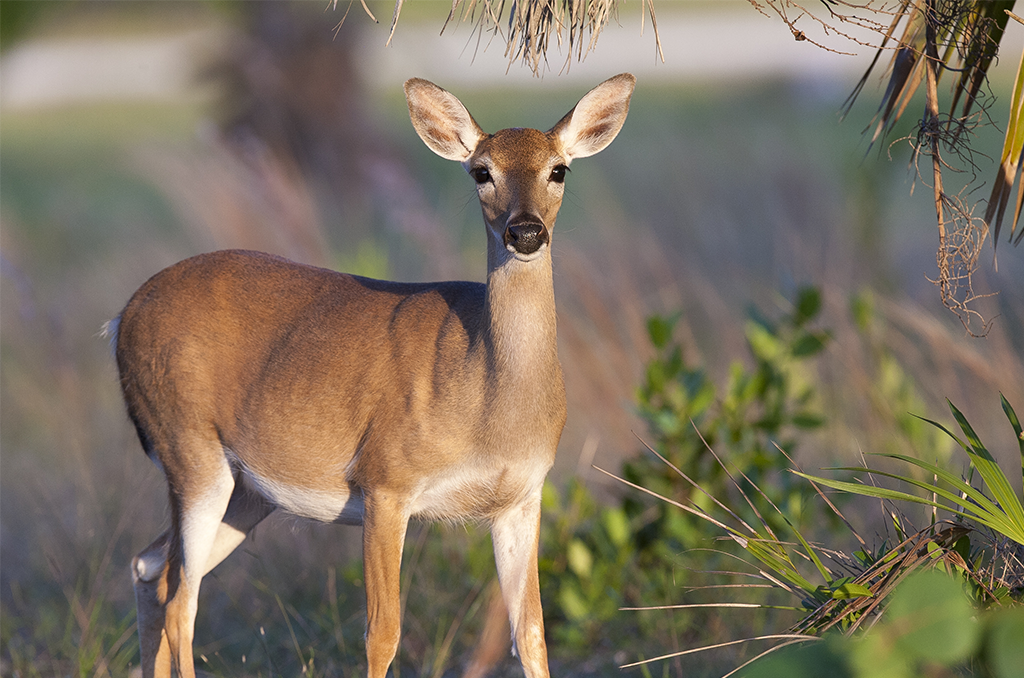Key Deer — Courtesy: Shutterstock — moosehenderson
When Hurricane Irma destroyed south Florida in September of 2017, it knocked out electricity for millions, inundated homes, and killed more than 30 people.
However, the devastation was not confined to humans.
In the Florida Keys, one of the Sunshine State’s most beloved species also took a beating: the Key deer, a small subspecies of white-tailed deer that evolved within peaceful isolation on the islands and is now protected under the Endangered Species Act. Irma slammed them into buildings, dragged them out to sea, and drowned them. “With Irma, we probably lost about 30% of the deer,” said Nova Silvy, a zoologist who has studied the deer since the 1960s on Big Pine Key, where most Key deers live.
Though the deer population has bounced back, the hurricane’s horrendous toll foreshadowed the alarming future these animals face. In the next century, the impacts of sea-level rise will most likely inundate many of the Florida Keys, including the endangered deer’s main habitat on Big Pine Key and its surrounding islands.
Despite this bleak prediction, the U.S. Fish and Wildlife Service (FWS), which administers the Endangered Species Act, has been working on proposals that would remove the Key deer of its endangered species status—even as the agency’s very own scientists have highlighted the danger of rising sea levels to the animals’ habitat, according to records.
These efforts started under the Trump administration, which saw an effort to remove protections for imperiled species, consequentially outraging conservationists as well as former FWS officials.
“There are things happening [to the Key deer] down there that would raise flags for any animal,” said Tom Wilmers, a retired FWS biologist who spent years working with the Key deer. “And yet the agency is in denial. I just don’t understand how delisting or downlisting that animal helps anybody.”
More broadly, the downfall of the Key deer is a window into the FWS’s bigger failure to adequately protect endangered species threatened by the climate crisis. Most notably, a secretive but consequential legal memo from 2008, signed by top interior department officials at the end of the George W. Bush administration, effectively declares other federal agencies and the FWS that decline to regulate greenhouse gas pollution that harms threatened and endangered animals under the Endangered Species Act. FWS’s inaction is consequential.
“We are putting out ten gigatons of carbon emissions per year, plus or minus, and those emissions are causing the planet to warm. And we know as the planet warms a lot of things are happening, from extreme weather events to waterways being ice-free for longer,” said Stuart Pimm, a professor of conservation at Duke University. “They may not be quite as direct as someone going out with a shotgun and killing a bald eagle, but they are every bit as potent a factor in causing species extinctions.”
Now, a group of conservationists and scientists, including Pimm, are counting on the Biden administration to take action by empowering the FWS to protect threatened species, including Key deer, sea turtles, polar bears, and more. However, until the White House does so, the Endangered Species Act will remain to face struggles when it comes to tackling the threats that these species face.
Are you interested in Florida’s nature? For stories like this and much more: Florida Insider is dedicated to educating, entertaining and informing its readers about everything Florida. Easy to read content at the palm of your hands and covering the stories that matter.
Melissa’s career in writing started more than 20 years ago. Today, she lives in South Florida with her husband and two boys.

